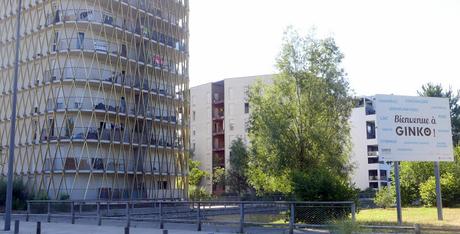
In recent years, there has been much talk about the Ginko eco-district to the north of Bordeaux, a dense new-build residential area that aims to tick all the right social and ecological boxes. It was about time Invisible Bordeaux headed there to get a feel of the area!
First things first though, what on earth are eco-districts (or écoquartiers in French)? The relevant Wikipedia page defines the term as designating “urban planning aiming to integrate objectives of sustainable development and social equity and reduce the ecological footprint of a neighbourhood, urban area, or region.” Cue Ginko, the first such high-level eco-friendly district in Bordeaux proper, built on land flanked to the west by the large artificial lake that took shape in the 1960s, to the north by the Bordeaux Lac hotel, business and exhibition complex, to the east by the massive Bordeaux Lac shopping centre, and to the south by the Aubiers high-rise residential estate.

The Ginko project took shape from 2006 onwards, with building work beginning in 2010. The first residents moved in in 2013, but the district will only be complete come 2022. The design of the Ginko eco-district was the brainchild of urban planners Christian Devillers and Olivier Brochet, with the project being rolled out by civil engineering firm Bouygues.
In terms of raw figures we’re ultimately talking a total surface area of 32.6 hectares comprising 2,700 homes for around 7,000 residents, a wide variety of housing types designed to attract an equally wide range of profiles, with greenery accounting for around 40% of the neighbourhood. The creation of Ginko was also coupled with a new northern extension to tram line C, not to mention the incorporation of a number of shops and restaurants, a primary school, and the first new Catholic church to be built in Bordeaux in 40 years.
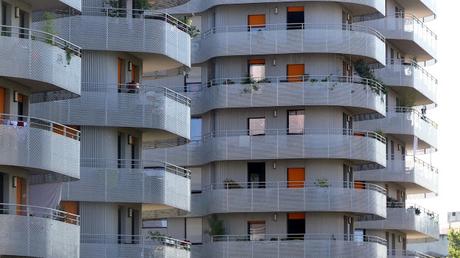
All of which is very well, but Ginko has struggled with a poor reputation over its first years of existence, with many social media-shaped fingers being pointed at the density of the area and its living quarters, the inhospitable atmosphere that reportedly reigns there at night, and the debatable quality of the building and furnishing materials used – as highlighted by the highly-publicised collapse of a fourth-floor balcony in 2015 (thankfully, no injuries were reported other than that of the tarnished image of Ginko and Bouygues). In surveys though, residents have stated that they are globally happy at Ginko although most have noted defects in their homes as well as raising issues about litter and noise in the area.
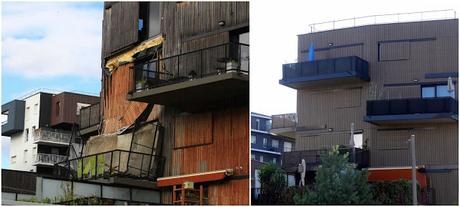
The infamous collapsed balcony (source: Sud Ouest) and, on the right, the restored balcony today.
Whatever, it was with an open and receptive mind that I headed there on a sunny Sunday morning. I opted to work my way from the north to the south of the district and back again, starting out near the “40 Journaux” tram stop, which also appears to be an unofficial depot for Auchan supermarket shopping trolleys. From there, the wide boulevard which stretches from north to south, Cours de Québec, very much splits the neighbourhood in two, and is itself divided down the middle by the tram line. Ground level anonymity is occasionally broken up by restaurants (including a pizzeria and an HFC, Halal Fried Chicken), a newsagents and a launderette, and at its heart by Vaclav Havel primary school, surrounded on all sides by tall fences that make it look a bit like a giant cage.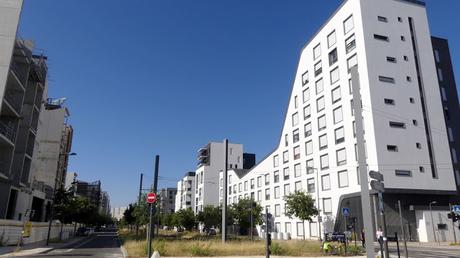
Cours de Québec splits Ginko in two. Note: the sky isn't always this blue.
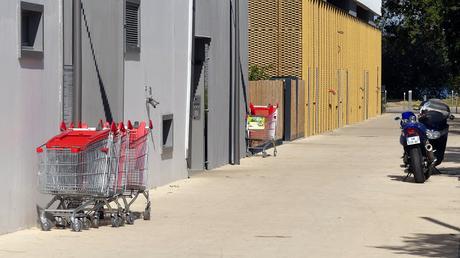
Tram stop shopping trolleys.

Ground-level food options: HFC and a pizzeria.
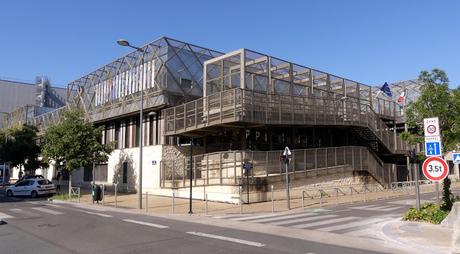
The cage-like Vaclav Havel primary school.
Heading off into the various perpendicular arteries takes us into a far more pedestrian environment with a number of nice touches such as water features complete with footbridges, a “boîte à lire” self-service borrow-and-lend library bookcase, not to mention further commercial units including a bakery, a co-working café and business centre, and a Montessori school that appears to be the antithesis of its nearby caged counterpart!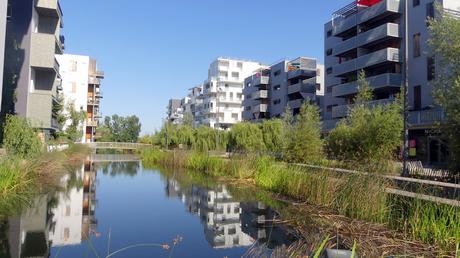
Walkways, water features and footbridges.
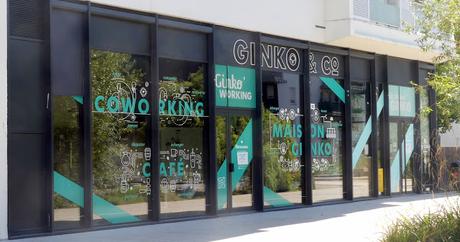
Co-working café and business center.
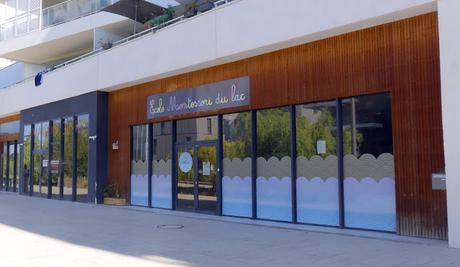
Montessori private school.
The pedestrian channels that run parallel to each other are connected by pleasant walkways that eventually lead to a children’s play area, Jardin du Clown Chocolat (named after the legendary Cuba-born clown who died and was buried in Bordeaux), which from the outside looking in seems to be reminiscent of the Teletubbies set. Moving further south, a linear park features obscure wooden structures and finishes off with a sports pitch that is such a bright shade of blue that it is probably clearly visible from outer space. A modern gymnasium marks the point where Ginko segues into the Aubiers district, as symbolized by the facility’s name, Gymnase Aubiers-Ginko.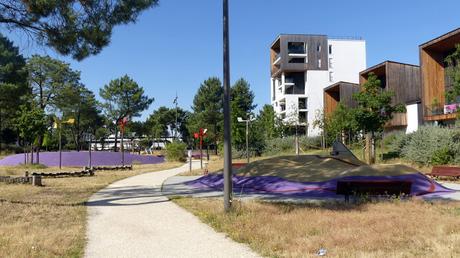
Jardin du Clown Chocolat.
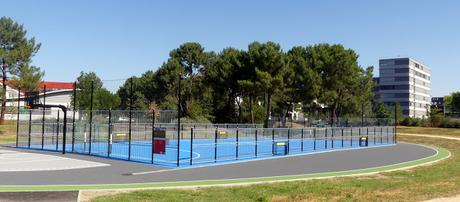
The bright blue sports pitch.
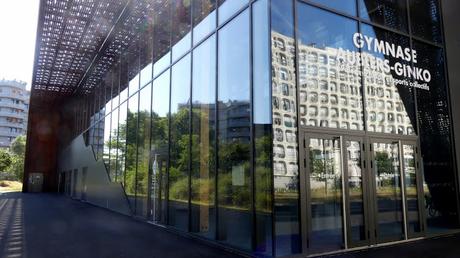
Gymnase Aubiers-Ginko. Note the reflection in the window of one of the famous Aubiers residences.
Working my way back northwards, by a large junction the aforementioned Notre Dame du Lac parish church, a distinctly modern edifice designed by Émilie Brochet, is tucked in among all the residential buildings. Across the road from the church is a whole section where, at the time of writing, work is still very much in progress, on further residential buildings but also on what has been termed the “Cœur Ginko” shopping area, which promises to be a natural connection between the residential quarter and the neighbouring Bordeaux Lac shopping center. This is where a large Cultura arts, crafts, book and music store is set to open. Bizarrely, to promote this new area to passers-by, the key message forwarded by Bouygues is the promise of 1,530 underground parking spaces.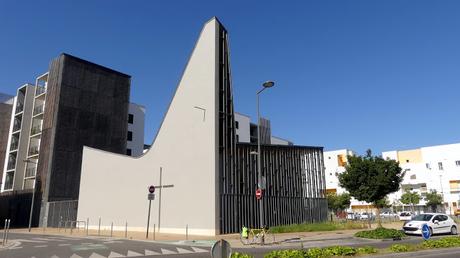
Notre Dame du Lac parish church.
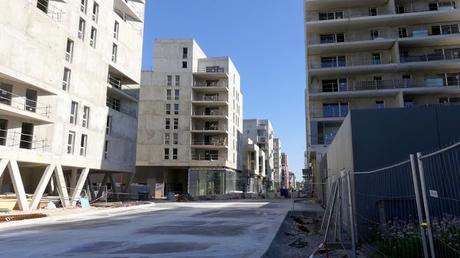
Work still very much in progress on the Cœur Ginko area.
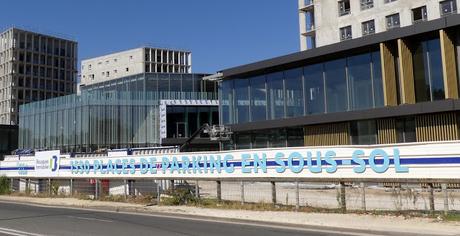
The attractive selling point of 1,530 underground parking spaces in the near future.
My journey finishes up towards the north-eastern tip of Ginko and what is referred to on maps as the “Chaufferie Biomasse Engie Services” (Engie Services biomass heating plant). It looks suitably modern and eco-friendly but also quite mysterious. Outside though, other than lettering spelling out the “énergie éco responsable” being generated inside, there is no further information on offer. The exterior is instead taken up by a large panel advertising the attibutes of the Cœur Ginko area.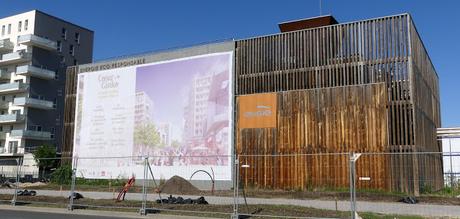
The enigmatic heating plant.
So, what was my general impression of a morning spent in the Ginko eco-district? Well, Invisible Bordeaux is not exactly renowned for its highly-opinionated analyses of local sights, and usually that is down to adopting a voluntarily observational stance. This time though, the general sense was genuinely one of nonplussed ambivalence – I didn’t exactly get very excited about the area, but didn’t find it especially unpleasant either. It is clearly a place to live rather than a place to visit and, this being a Sunday morning, I didn’t expect it to be buzzing, but in fact there was hardly anybody out and about enjoying the fresh air (hence the lack of people on the photos published here...).And perhaps that is where things are very much make or break for Ginko. Will the neighbourhood be able to get residents out of their houses and apartments to form a new community? Will the schools, play areas and shared spaces become local hubs for people to meet, greet and get to know each other? At this point in time, that process is very much in its nascent phase; only time will tell how well Ginko will age and whether the eco-district will develop its own sense of identity, its own character and its own distinctive feel and atmosphere which, at present, doesn’t seem to have developed when viewed as an outsider. I will have to check back regularly to see how things progress.
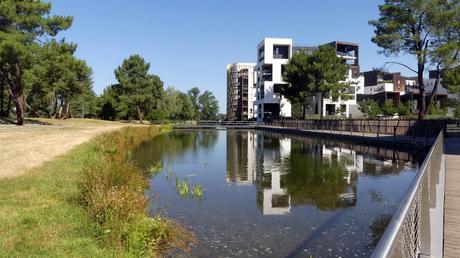
> Find it on the Invisible Bordeaux map: Ginko eco-district, Bordeaux
> Official Ginko website to find out how you too can live the Ginko dream: www.ecoquartier-ginko.fr
> The map I used to find my way around Ginko is available here.
> Ce dossier est également disponible en français !
